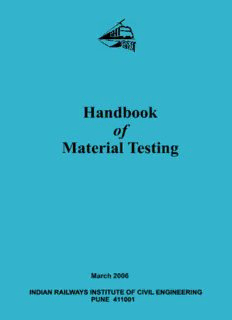
hand book for lab - area PDF
Preview hand book for lab - area
Handbook of Material Testing March 2006 Handbook of Material Testing PREFACE While designing a structure, engineer assumes certain value of strength for each of material being used therein. When the structure is being constructed, it is the bounden duty of the field engineers to get the same validated by regular testing of material. The quality of materials used in any infrastructure does play a vital role with regard to its ultimate strength and durability in the long run. Hence, the materials need to be tested according to certain standard procedures developed by ASTM, BIS, RDSO to give a clear picture of material strength. The “Handbook of Material Testing” is an attempt by IRICEN to bring together the standard test procedures for materials frequently used in the civil engineering infrastructure of Indian Railways. It is hoped that this will be a helpful guide to the field engineers. A list of suppliers of various testing equipments has also been provided alongwith their addresses to enable the engineers in setting up of a field laboratory, in case the need be. Any suggestions to ameliorate the content of this handbook would be welcome. Shiv Kumar Director IRICEN, Pune ACKNOWLEDGEMENT Strength and durability of any infrastructure is a reflection of the quality of materials used. Quality control of materials can only be ensured through certain standard test procedures designed by ASTM, BIS, RDSO and others. The “Handbook of Material Testing” is an attempt towards this aim, of creating a collection of standard test procedures for materials, commonly used in civil engineering infrastructure on the Indian Railways. This will serve as a guide to the field engineers. The readers are advised in their interest to refer to the latest standards to avoid any omission, due to changes/amendments in the standards. The handbook also includes a list of suppliers of material testing equipments, alongwith their addresses to facilitate the setting up of a field laboratory. The support rendered by the faculty and staff of IRICEN in this endeavour, needs mention. Shri Praveen Kumar, Professor/ Computers and Shri J.M. Patekari, Chief Technical Assistant, have been of technical assistance and Shri Vijayakumaran. V, my Personal Assistant, has been extremely useful in the task of word processing. I am thankful to Shri Shiv Kumar, Director/IRICEN for his guidance and encouragement. R.K. Verma Sr. Professor/Track IRICEN, Pune Table of Contents 1. Tests on Cement 1.1 Fineness 1 1.2 Consistency 3 1.3 Initial and final setting time 5 1.4 Soundness 7 2. Tests on Aggregates 2.1 Sieve analysis 9 2.2 Water absorption 13 2.3 Aggregate abrasion value 15 2.4 Aggregate impact value 18 2.5 Aggregate crushing value 21 3. Tests on Fresh Concrete 3.1 Workability 23 3.1.1 Slump 23 3.1.2 Compacting factor 25 3.1.3 Vee-Bee 27 4. Tests on Hardened Concrete 4.1 Non-destructive tests 29 4.1.1 Rebound hammer 29 4.1.2 Ultrasonic pulse velocity 31 4.2 Compression test 34 5. Tests on Soil 5.1 Water content 38 5.1.1 Oven drying method 38 5.1.2 Calcium carbide method 41 5.2 Particle size distribution 44 5.3 Liquid limit 47 5.4 Plastic limit 50 5.5 Free swell index 52 5.6 Specific gravity 54 5.7 Maximum dry density and optimum moisture content 57 5.8 In-situ dry density 61 5.8.1 Core cutter method 61 5.8.2 Sand replacement method 63 6. Tests on Blanket Material 68 7. Tests on Bitumen 7.1 Bitumen content 72 7.2 Specific gravity 74 7.3 Marshall stability 76 7.4 Penetration 78 7.5 Flash point and fire point 80 7.6 Softening point 83 7.7 Ductility 86 ANNEXURES 89 to 99 List of suppliers of material testing equipments alongwith their addresses 100 1. TESTS ON CEMENT 1.1 FINENESS AIM To determine the fineness of cement by dry sieving as per IS: 4031 (Part 1) - 1996. PRINCIPLE The fineness of cement is measured by sieving it through a standard sieve. The proportion of cement, the grain sizes of which, is larger than the specified mesh size is thus determined. APPARATUS FIG. 1 : IS SIEVE i) 90µm IS Sieve ii) Balance capable of weighing 10g to the nearest 10mg iii) A nylon or pure bristle brush, preferably with 25 to 40mm bristle, for cleaning the sieve 1 PROCEDURE i) Weigh approximately 10g of cement to the nearest 0.01g and place it on the sieve. ii) Agitate the sieve by swirling, planetary and linear movements, until no more fine material passes through it. iii) Weigh the residue and express its mass as a percentage R , 1 of the quantity first placed on the sieve to the nearest 0.1 percent. iv) Gently brush all the fine material off the base of the sieve. v) Repeat the whole procedure using a fresh 10g sample to obtain R . Then calculate R as the mean of R and R as a 2 1 2 percentage, expressed to the nearest 0.1 percent. When the results differ by more than 1 percent absolute, carry out a third sieving and calculate the mean of the three values. REPORTING OF RESULTS Report the value of R, to the nearest 0.1 percent, as the residue on the 90µm sieve. 2 1.2 CONSISTENCY AIM To determine the quantity of water required to produce a cement paste of standard consistency as per IS: 4031 (Part 4) - 1988. PRINCIPLE The standard consistency of a cement paste is defined as that consistency which will permit the Vicat plunger to penetrate to a point 5 to 7mm from the bottom of the Vicat mould. APPARATUS FIG. 2 : VICAT APPARATUS i) Vicat apparatus conforming to IS: 5513 - 1976 ii) Balance, whose permissible variation at a load of 1000g should be +1.0g iii) Gauging trowel conforming to IS: 10086 - 1982 3
Description: